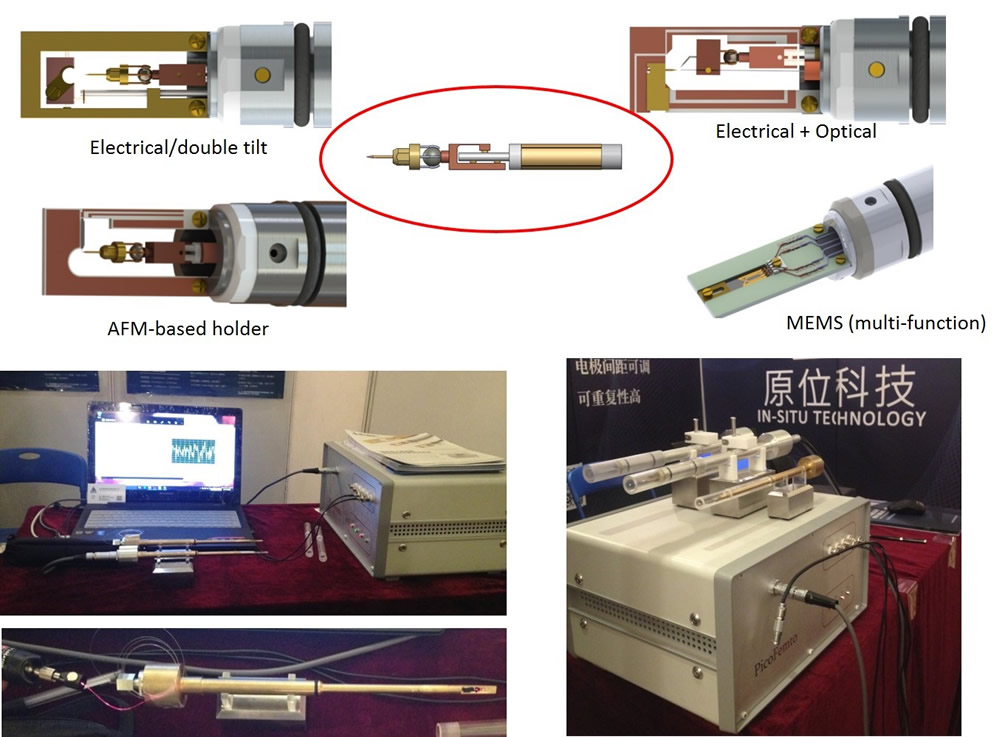In situ EM
Developing in-situ TEM technique for the atomic-scale experiments, the structural and physical properties will be measured to reveal the microscopic mechanism of the quantum behavior and emergent phenomena. We focus on the following two areas:
1) The basic physics in the strongly correlated system: correspondence of quantum transport with electronic structure at atomic scale, the coupling effect of physical freedom and its manipulation by external applied field.
2) The mechanism of high-efficiency energy conversion and storage: the synergistic effect between atomic structure and electronic structure involved in interface process, the role of surface, atom occupation site and defects in the physical and chemical processes, and the phase transition induced property evolution. This project is expected to attain breakthrough in new-energy application oriented fundamental research.
Novel Electron Microscopy Imaging Methodology
The research paradigm of materials science highly correlated with the accurate characterization of atomic structure, which is related to the physical and chemical properties of materials. In 1959, Richard Feynman delivered his famous lecture at the annual meeting of American Physical Society and said that,“It would be very easy to make an analysis of any complicated chemical substance; all one have to do would be to look at it and see where the atoms are...” Still, it remains a critical challenge to characterize the atomic structure with superior accuracy in modern matter science, where electron microscope plays an indispensable role. With recent advances in spherical aberration correctors and direct electron detectors, worldwide frontier TEM labs have been allocating increasing efforts in developing the novel imaging methods. These newly developed methods would be usually accompanied with the improvement of novel imaging approaches.
Our research focused on the three-dimensional electron tomography and its application in material physics. By combining deep learning technique and novel detecting approaches, such as AI-based high-throughput images processing, 4D-STEM, 4D-EELS, we manage to develop the state-of-art atomic electron tomography to conduct basic, thorough and multidimensional research in materials science.
Low Dimensional Materials Synthesis and Application
Controlled growth, synthesis, and properties manipulation of low-dimensional nanostructures including light-element binary B-N and ternary B-C-N 2D atomic layer films and nanosheets, metal oxide films, metal nitrides plasmonic nanoarchitectures, and other related quantum materials, with emphases on following aspects of interests:
1) Growth kinetics control of the truly ternary-phase B-C-N atomic layers and exploration of their novel electrical and optical properties.
2) Sublattice-selective doping and surface chemical functionalization of 2D BN nanosheets to achieve spin polarization and π-electron based magnetism.
3) Controlled high-temperature synthesis of nanoplasmonic TiN and ZrN nanoparticles and their metal-semiconductor heterostructures to explore the plasmonic hot-carriers enabled catalytic processes for energy storage or conversion (water-splitting and nitrogen reduction etc.).


Research Overview
Low-dimensional structures (as well as surface and interface) have novel physical properties and intrinsic quantum behaviors. The emergent phenomena of lowdimensional structures are attracting more and more interests in both fundamental research and device applications. The atomic-level growth and structure-property characterization is still a challenge, so far. Research on the correlation between properties and atomic/electronic structures is one of the basic tasks in condensed matter physics research. In-situ transmission electron microscopy (TEM) method is powerful in a way that it can directly correlate the atomic-scale structures with physical properties. In this group, based on our before works on the synthesis and property of low-dimensional nanostructures and their in-situ we will continue to develop the new in-situ TEM technique to probe the emergent phenomena in low-dimensional structures.